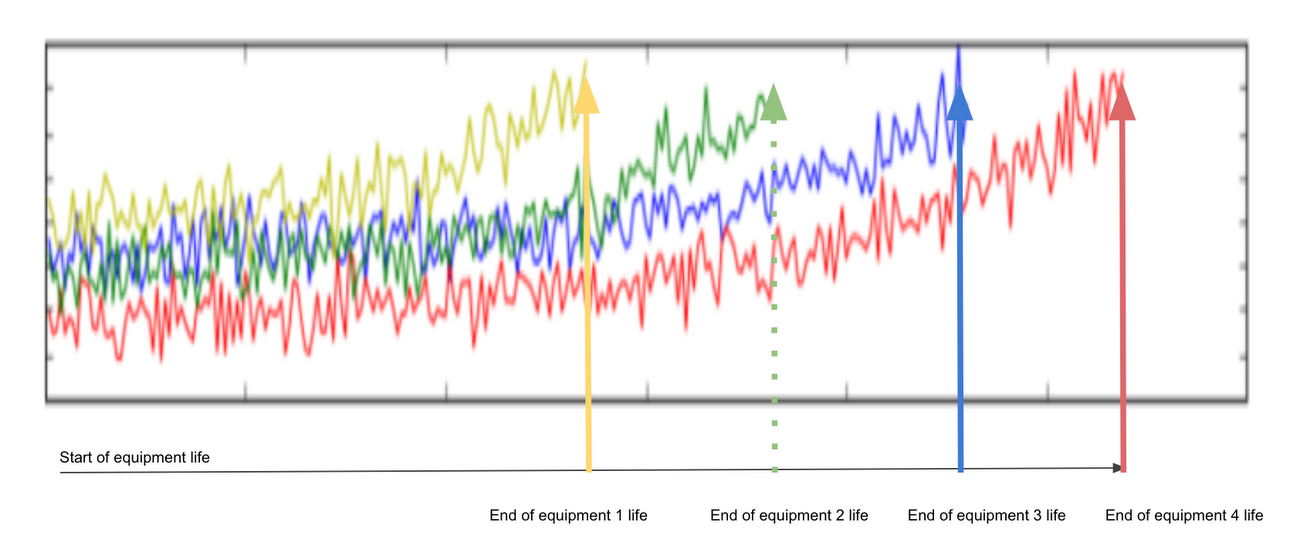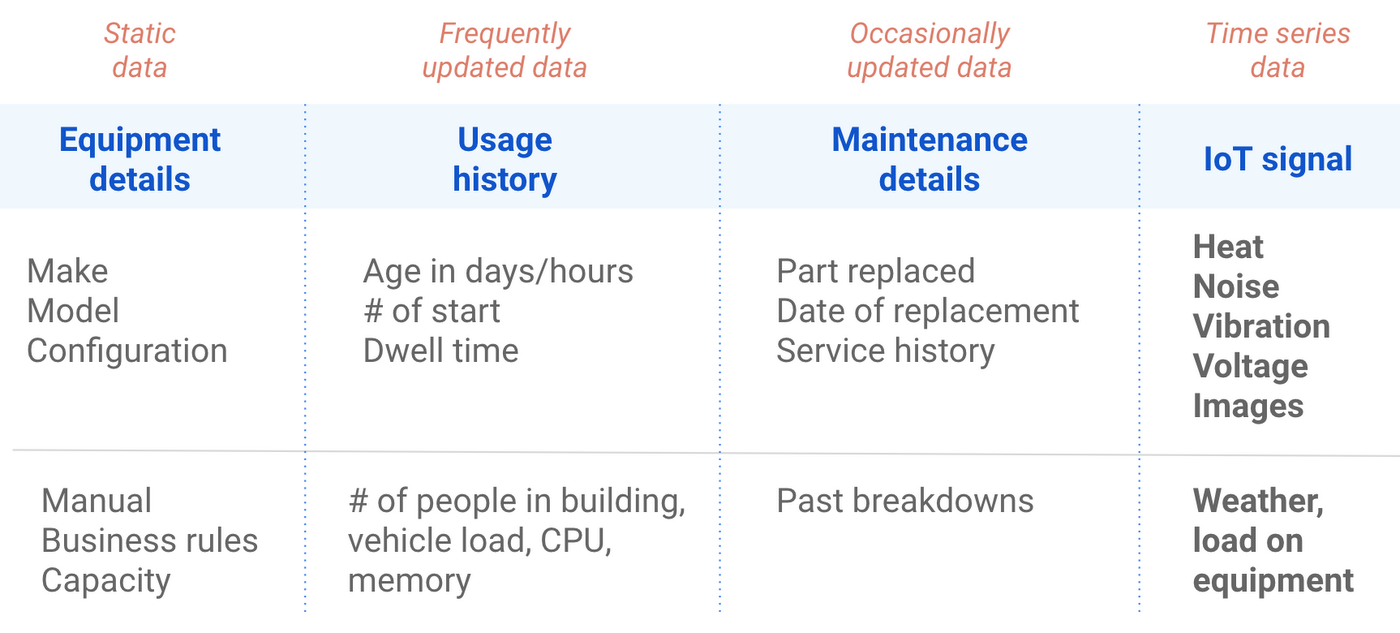A strategy for implementing industrial predictive maintenance: Part I
Prashant Dhingra
Machine Learning Lead, Advanced Solutions Lab, Google Cloud
A recent phenomenon called Industry 4.0 marks an industry-wide shift in manufacturing: factories are becoming smarter. Accordingly, plant operators strive for increased productivity, improved operational efficiency, and better safety, given the technological tools newly available to them. Many manufacturing facilities maintain a combination of both new and old machines. The first step to make a factory smarter is enable predictive maintenance (PdM) capabilities.
Predictive maintenance focuses on identifying patterns in both sensor and yield data that indicate changes in equipment condition, typically wear and tear on specific equipment. With predictive maintenance capabilities, companies can determine the remaining value of assets and accurately determine when a manufacturing plant, machine, component or part is likely to fail, and thus needs to be replaced.
In this first post in our three part series, we’ll explain how predictive maintenance can function to reduce downtime, reduce maintenance costs and improve operational effectiveness and safety, by identifying impending failures before they occur.
Business benefits
All types of equipment—machines, batteries, and other mechanical and electrical components - degrade with time and use. In the long run, every piece of manufacturing equipment will reach the end of its useful life.
In the past, companies have used schedule-based maintenance (also referred as planned maintenance or time based maintenance) systems In many cases the approach focuses on reducing failures and end up replacing machines that could have been service for longer, because the schedule assumes worst-case lifetimes for critical pieces of manufacturing tooling.
In certain scenarios, companies have tried to use condition-based maintenance methods to maintain or replace equipment at exactly the right time—just before failure. However, this condition-based method requires observing the equipment at regular intervals.
Using machine learning when you mine multiple parameters and accurately predict when equipment is likely to fail, predictive maintenance can yield the following benefits:
Reduce downtime
Increase productivity and operational effectiveness
Improve safety
Understand the root causes of failures
Derive asset values, even for machinery of varying age and condition
Technical capabilities
Predictive maintenance identifies condition of machinery or equipment and determines whether a specific machine is going to fail or not. This new paradigm is enabled by connected machines that generate large amount of instrumented data and machine learning capabilities that can derive meaning from this data.
Several technology trends are accelerating the present industrial revolution by enabling predictive maintenance:
Big Data (data warehouses)
Cloud Computing
Machine Learning (ML)
Edge computing
Internet of Things (IoT)
Given these technologies, machines, factories, and manufacturing processes have become intelligent, integrated, and data-driven. Predictive maintenance techniques collect data from machines such as temperature, vibration, and sound using sensors. Once data is collected and normalized, you can employ predictive analytics by applying machine learning techniques.
As you collect multiple parameters from highly instrumented equipment, it becomes important to use machine learning techniques to identify failure patterns. With machine learning you can identify patterns that indicate upcoming failure. With a deep learning-based technique, you can also identify patterns inside a pattern that indicates failure.
A framework for designing your predictive maintenance solution
To build a predictive maintenance solution, you should define your use case in detail by describing what you wish to predict, its business benefits, the data signals available to you, and the hypotheses you have. The signals and failure examples you collect need to match your use case.
Common use cases for predictive maintenance
In this post, we describe common use cases to build predictive maintenance scenarios.
Some common use cases related to predictive maintenance include:
1. Will this equipment fail?
In this scenario, your goal is to predict whether equipment will fail in a given period or not. In machine learning terms, this is referred to as a classification problem.
You should define “period” for failure: will this machine fail in next ‘1 day’ or ‘1 week’ or ‘1 month’?
To solve this problem you need to have labeled data about:
Normal instances
Failure instances
You should check the feasibility of your use case by validating that you see a separation pattern between normal and failure instances. For example, if your goal is to predict “whether this machine will fail in the next 7 days or not,” you should check whether the last 7 days of data show any difference, versus prior data.
In many scenarios, humans may not be able to identify such differences, but a deep learning model might be able to find a subtle or nuanced difference.
2. What is the remaining life of your equipment?
In this use case, your goal is to determine the remaining life or value of assets. In machine learning terminology, this is referred to as a regression problem.
To solve this problem you need to have labeled data about machine at various stages e.g when machines is new, 90% remaining life, 80% remaining life, and fixed intervals down to 1% remaining life.
3. Is there an anomaly in equipment behavior?
In this use case, you focus on identifying abnormal, unusual, or irregular patterns, as they contrast to how you expect equipment to work in a typical fashion. Predictive maintenance techniques seek out abnormalities in data and trigger an alert as soon as the machine produces data in an abnormal range.
4. Optimize equipment settings
In the above scenarios, a human designs the predictive maintenance model. Once the system can predict whether equipment will fail or not, a human looks at the data to make a decision. But one can also use machine learning for optimization of manufacturing processes. In these use cases, the system automatically determines ideal behavior (settings) within a specific context to maximize performance.
Most modern manufacturing facilities house complex interactions of various mechanical and electronic controls. Modern data centers have similar challenges.
This case study describes machine learning optimizations for Data Centers. The paper provided details how Google’s infrastructure team used sensor data in Google data centers to model energy efficiency. They were able to design save 40% energy for cooling.
Model applications include data center simulation to evaluate a new plant configuration, energy efficiency performance, and identifying optimization opportunities.
We recommend that companies start their AI journey by implementing classification and regression models for predictive maintenance. Once they have robust pipeline and success with machine learning, they should consider building more advanced optimization models.
Common datasets and schema
The most important requirement to build a predictive maintenance solution is to have the right dataset. It is ideal to have a dataset that shows identifiable equipment degradation.
The figure below shows a dataset of four sample pieces of equipment that are each denoted by a different color. Each piece of equipment has a different life span.
For each piece of equipment, we collected data starting when the equipment was new until the point in time at which the equipment failed.


Next you’ll learn some suggested signals you should collect for building predictive machine learning models.
1. IoT data
To determine the current condition of a machine—specifically, an anomaly or increased possibility of failure—the most important signals are IoT signals. Heat, vibration, and sound produced by machinery can indicate how much degradation has happened thus far. Machine vision and visual inspection also indicate machine condition. For batteries, battery capacity voltage provides some insight about a battery degrade status. In most cases, you can build predictive maintenance model by using IoT or visual signals such as temperature, vibration, sound, voltage, image, etc.


2. Metadata about equipment (e.g. make, model, or revision)
Many pieces of equipment have various versions, models, and settings. For example a car engine built in 2018 is likely to produce less heat and noise compared to one built in 2010. The second most important data value for building predictive maintenance model is often one of the following: make, model, configuration, or operation settings.
The make and model of a piece of equipment is static data and does not change at every interval. It is generally stored as asset metadata in your system. Including this small dataset makes your analytics system even more powerful.
3. Usage history
The third category of data attributes is usage history. For example:
A car driven 100,000 miles is likely to incur more wear and tear than a car driven 20,000 miles
An engine operated for 20,000 hrs is likely to incur more wear and tear than engine operated for 5000 hours
A bus that is typically overloaded and carries 100 passengers daily is likely to incur more wear and tear than school buses that carry 30 children daily
A pizza delivery car battery that starts and stops the engine 100 times a day is likely to fail more often than a car battery used only twice per day.
Usage history data is an important indicator for equipment condition. A car driven 100,000 miles probably will produce more heat than a car driven 20,000 miles. One can argue that heat signal (compounded over time) should be enough to indicate failure. If a new car starts showing symptoms that should be shown many years of degrade indicate not only failure but also underlying faults that contribute to faster degradation.
You should consider updating usage data at regular intervals (e.g. weekly or monthly) and include it as input data in your predictive maintenance solution.
4. Maintenance data
A fourth category of data that enhances the effectiveness of your predictive machine learning models is information about maintenance and service history. For example:
If an equipment battery is recently inspected/serviced it is unlikely to breakdown due to battery compared to other equipment that have not been inspected for a long time.
If a piece of equipment is recently serviced or certain parts are replaced, it should be obvious in signals recorded by your system.
Conclusion
In the cases of complex systems such as manufacturing facilities and aircraft engines, the top most advantage of using Industrial IoT systems is predictive maintenance. Predictive maintenance will improve the longevity of most equipment. It will reduce unscheduled downtime of your assembly line in a manufacturing facility, thereby making production more reliable.
Predictive maintenance not only provides cost savings, but it enables new business models. Equipment that collects usage data, publishes health status, and predicts failure will be able to charge a premium for built-in predictive maintenance capability. Manufacturing of such equipment may enable new leasing, rent, and maintenance-as-service model in which the manufacturer charges a price based on throughput of the equipment.
To start the predictive maintenance journey, first define use case. Then ensure that you already have or can generate a dataset that matches your use case. To validate that your dataset has the matching pattern to build your model, you should use simple data exploration techniques to determine whether your data includes degradation or failure patterns. Once you get evidence of pattern, you are ready to build machine learning models.
Google Cloud Platform includes following components to easily build predictive maintenance solution.
IoT and Pub/Sub enable data ingestion
Cloud Dataflow allows data processing
BigQuery provides you with an enterprise-scale data warehouse
Data Studio, built on Google Drive, enables you and your team to share visualizations
Cloud Machine Learning built on TensorFlow for Model building


